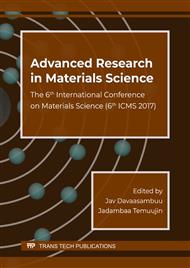[1]
S.P. Bardakhanov, I.V. Vasiljeva, N.K. Kuksanov, S.V. Mjakin, Surface functionality features of nanosized silica obtained by electron beam evaporation at ambient pressure, Advances in Materials Science and Engineering, vol. 2010, 2010, Article ID 241695, 5p.
DOI: 10.1155/2010/241695
Google Scholar
[2]
V.V. Syzrantsev, A.P. Zavyalov, S.P. Bardakhanov, The role of associated liquid layer at nanoparticles and its influence on nanofluids viscosity, Int. J. of Heat and Mass Transfer, vol. 72, 2014, pp.501-506.
DOI: 10.1016/j.ijheatmasstransfer.2013.12.082
Google Scholar
[3]
P. Cheviron, F. Gouanvé, E. Espuche, Effect of silver nanoparticles' generation routes on the morphology, oxygen, and water transport properties of starch nanocomposite films, J. Nanopart. Res., vol. 17, 2015, p.364.
DOI: 10.1007/s11051-015-3173-4
Google Scholar
[4]
M. Ya. Gen, Yu. I. Petrov, Disperse Condensates of Metal Vapor, Russ Chem Rev, vol. 38 (12), 1969, p.1007–1024.
DOI: 10.1070/rc1969v038n12abeh001889
Google Scholar
[5]
I. Petrov, Physics of small particles, Nauka, Moscow, (1982).
Google Scholar
[6]
G.A. Niklasson, A. Torebring, C. Larsson et al., Fractal dimensions of gas-evaporated Co aggregates: role of magnetic coupling, Phys. Rev. Lett., vol. 60, 1988, pp.1735-1738.
DOI: 10.1103/physrevlett.60.1735
Google Scholar
[7]
P.J. Meakin, The effects of random bond breaking on diffusion limited cluster-cluster aggregation, Chem. Phys., vol. 83, 1985, pp.3645-3649.
DOI: 10.1063/1.449119
Google Scholar
[8]
P.J. Meakin, R. Jullien, The effects of restructuring on the geometry of clusters formed by diffusion-limited, ballistic, and reaction-limited cluster – cluster aggregation, Chem. Phys., vol. 89, 1988, pp.246-250.
DOI: 10.1063/1.455517
Google Scholar
[9]
А.А. Lushnikov, А.V. Pahomov, G.А. Chernyaeva, Fractal size of aggregates, produced by a laser vapouring of metals, Reports of the Academy of Science, vol. 192, 1987, p.86.
Google Scholar
[10]
S.R. Forrest, T.A. Witten, Long-range correlations in smoke-particle aggregates, J. Phys. A., vol. 12, 1979, p. L109 – L117.
DOI: 10.1088/0305-4470/12/5/008
Google Scholar
[11]
S.P. Bardakhanov, A.I. Korchagin, N.K. Kuksanov, A.V. Lavrukhin, R.A. Salimov, S.N. Fadeev, V.V. Cherepkov, Nanopowder production based on technology of solid raw substances evaporation by electron beam accelerator, Materials Science and Engineering: B, vol. 132, 2006, pp.204-208.
DOI: 10.1016/j.mseb.2006.02.038
Google Scholar
[12]
G. Dobrescu, E. Balabanova, M. Zaharescu, N.I. Ionescu, TEM Micrograph fractal analysis of silica powders, Revue Roumanie de chimie, vol. 53, 2008, p.217–221.
Google Scholar
[13]
Y.P. Dikov, I.A. Brytov, Y.N. Romashenko, S.P. Dolin, Peculiarities of electron structure of silicates, Nauka, Moscow, 1979, p.128.
Google Scholar
[14]
B. Mandelbrot, The fractal geometry of nature. San Francisco: W.H. Freeman, 1983, p.656.
Google Scholar
[15]
U.A. Abzaev, U.S. Sarkisov, D.A. Afanas'ev, A.A. Klopotov, N. Gorlenko, V.D. Klopotov, Structural-phase state analysis of calcium mono-aluminate, Advanced Materials Research, vol. 1013, 2014, p.102–107.
DOI: 10.4028/www.scientific.net/amr.1013.102
Google Scholar
[16]
A.K. Rappe, K.S. Colwell, Application of a universal force field to metal complexes, Inorg. Chem, vol. 32, 1993, p.3438–3450.
DOI: 10.1021/ic00068a012
Google Scholar
[17]
V.V. Syzrantsev, K.V. Zobov, A.P. Zavjalov, S.P. Bardakhanov, The associated layer and viscosity of nanoliquids, Doklady Physics, vol. 60, 2015, pp.46-48.
DOI: 10.1134/s1028335815010103
Google Scholar
[18]
А.P. Zavyalov, Т.А. Brusentseva, L.S. Vikulina, S. Bardakhanov, Т.А. Chimytov, V.V. Syzrantsev, The interaction of silica nanoparticles with polymers, Nanoindustry, vol. 39, 2013, pp.32-35.
Google Scholar


